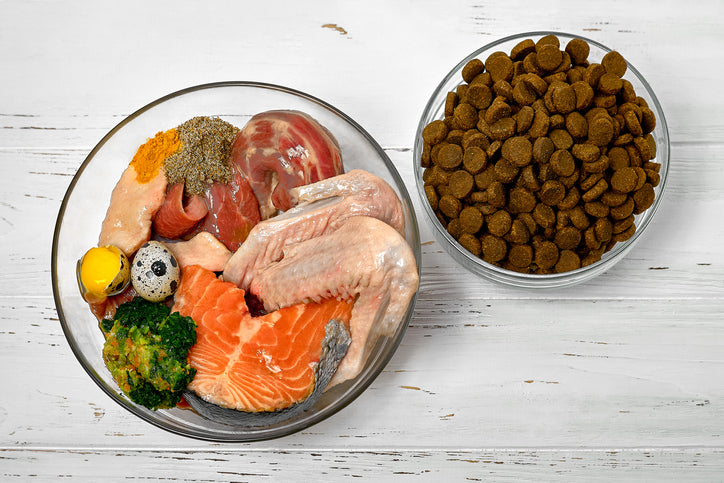From Kibble to Raw

Raw feeding has become increasingly popular in recent years, with many pet owners opting for this feeding method over traditional kibble diets. This shift in feeding habits can be attributed to a growing understanding of the importance of proper nutrition in maintaining optimal health in our pets. In this article, we will explore the benefits of raw feeding and why it may be the better choice for your furry friend.
One of the main reasons raw food is considered superior to heat pressed kibble is that it is a biologically appropriate diet for dogs and cats. Dogs and cats are natural carnivores, meaning their bodies are designed to thrive on a diet of raw meat, bones, and organs. Raw feeding provides the essential nutrients and enzymes that are naturally present in the food and are essential for optimal health.
In contrast, heat pressed kibble goes through a cooking process that destroys many of the important nutrients and enzymes that are needed for optimal health. Kibble is made up of processed, extruded ingredients that are then formed into dry pellets. The cooking process, along with the addition of synthetic vitamins and minerals, is meant to compensate for the loss of natural nutrients during processing. However, these synthetic additives are not always as effective as the naturally occurring nutrients found in raw food.
Furthermore, kibble is often made from low quality, processed ingredients that are high in fillers, preservatives, and other additives. These additives can cause a range of health problems, including digestive issues, skin problems, and even cancer. Additionally, kibble often contains high levels of carbohydrates, which are not a natural part of a dog or cat's diet. Raw food, on the other hand, is typically made from high quality, whole food ingredients that are free from fillers, preservatives, and other additives that are commonly found in kibble.
Another benefit of raw feeding is that it provides a more natural balance of macronutrients for dogs and cats. Raw food is typically high in protein and healthy fats, which are essential for maintaining muscle mass, energy levels, and overall health. On the other hand, kibble is often high in carbohydrates and can be lacking in essential nutrients. Many pet owners report that their pets have improved energy levels, better coat quality, and better overall health after switching to a raw food diet.
One of the most significant benefits of raw feeding is the positive impact it can have on your pet's digestive health. Raw food is more easily digestible than kibble, and it contains natural enzymes and probiotics that can aid in digestion. Many pets who switch to a raw food diet experience improved digestion, reduced flatulence, and fewer bowel movements. This is because raw food is more biologically appropriate for pets, and their bodies are designed to digest raw meat, bones, and organs.
In addition, raw food is more palatable to dogs and cats, making it easier for them to digest and absorb nutrients. Many pets who switch to a raw food diet experience increased appetite and less picky eating habits. This is because raw food has a more natural taste and smell than kibble, which often contains artificial flavours and additives to make it more appealing to pets.
While the benefits of raw feeding are clear, it is essential to handle raw food safely and follow proper food safety guidelines to minimize the risk of contamination.
In conclusion, raw feeding is a natural, nutrient-dense, and biologically appropriate diet for dogs and cats. While heat pressed kibble has been a popular choice for many years, it is becoming increasingly clear that raw food is a superior option for pet owners who want to provide their pets with optimal nutrition and health. By switching to a raw food diet, you can help your pet to live a healthier, happier life.

